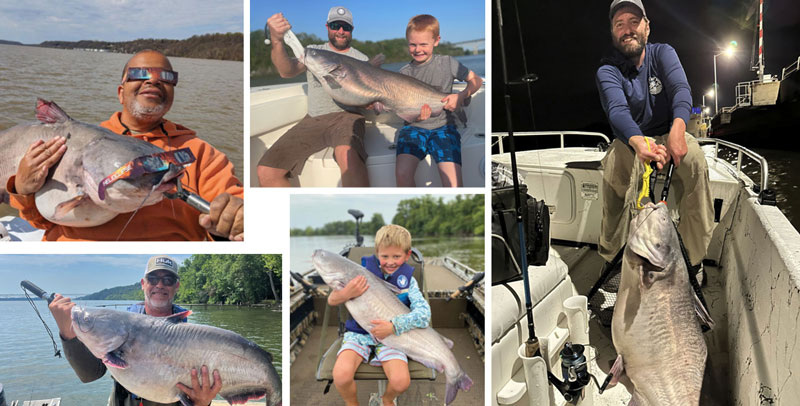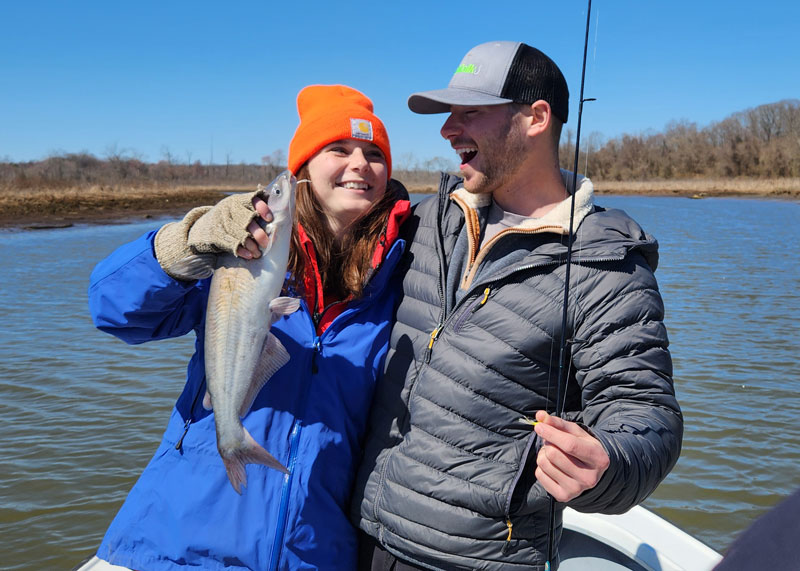Like ‘em or not, blue catfish are here to stay in the Chesapeake. Long adapted to our country’s big Midwestern rivers, they have adjusted easily to Virginia’s large tidal rivers over the past 50 years, and to the Potomac for nearly as long.

The initial understanding was that as freshwater fish, they would stay in the upper “tidal fresh” portions of those rivers. But that assumption proved incorrect. Heavy rains in 2018-19 let them escape into the Chesapeake’s mainstem and colonize rivers to the north; the Nanticoke, Choptank, Chester, and the Upper Bay, which is, after all, the tidal Susquehanna. At this point, there’s not much chance of eradicating these invaders. So what’s to do about them?
First, like so many other Bay issues, this one is complicated. The fish pose both significant problems and genuine opportunities. The challenge is minimizing the damages while maximizing the advantages. Though scientists have been studying them carefully since they were first introduced, they defy simple answers, even from one river to another.
Blue Catfish Basics
Multiple diet studies show these fish to be hungry and opportunistic, ready to eat whatever is available wherever they are, including vegetation and shellfish as well as any finfish they can fit into their mouths. For example, in the brackish water of the lower James River, they cheerfully eat blue crabs. But up the river between Hopewell and Richmond, the primary forage is the ever-abundant gizzard (mud) shad. The same goes for a Maryland river like the Nanticoke.
The age and size structure of the stocks, however, vary from river to river, depending on how long the cats have been established there and how much food is available to them. Invasive species tend to explode when introduced into a favorable environment, as fishery scientists have documented in the James, Rappahannock, and Potomac, but population studies show that increasing harvest over time reduces the number of large fish and increases the biomass of smaller ones. It also depresses the population.
The James River offers a good example. In the 1990s Virginia issued citations for fish over 20 pounds to trophy anglers every week year-round, with fish over 70 pounds not uncommon and some breaking 80. Since then, the number of big fish has dropped considerably even though catfish anglers carefully release most of their trophies after weighing and measuring them. A review of Angler of the Month awards from the state’s Department of Wildlife Resources shows only a handful of fish over 50 pounds over the past 10 years (though it does list a 112-pound blue cat from the Rappahannock in late January of 2020).

Maryland’s State Record is an 84-pound fish from the Potomac, caught back in 2012. The big fish are still there, but not as many of them. Remember, though, that blue catfish have had access to the Patuxent, Nanticoke, Choptank, Chester, and Upper Bay for less than a decade. Still to be determined is how—and how big—they will grow in those waterways in the coming years.
Blue Catfish Problems
As noted, blue catfish cheerfully and aggressively eat whatever is available wherever they are. They have turned out to be tolerant of more salinity than expected, and they multiply rapidly, especially when they first arrive in new waters. In springtime, they threaten valuable rockfish, white perch, yellow (ring) perch, American and hickory shad, and river herring (alewives and bluebacks) spawning in those waters, as well as their young as they grow through the summer and fall. Further downriver, they prey on blue crabs and small members of the drum family (spot, croakers, sea trout, and puppy drum). State agency biologists and university scientists have built a large body of blue cat diet studies for specific rivers, and those studies continue to document the ways those diets evolve over time. Remember that there are not many simple answers in a big, complex estuary like the Chesapeake.
A footnote: Fortunately, a huge portion of their diet throughout the tidal fresh and low brackish waters is gizzard (mud) shad. These abundant “debris feeders” convert the rivers’ vast quantities of formerly alive plant and animal material—much of it accumulated in the bottom sediment—into high-calorie flesh. Savvy readers will also note how important those particular forage fish are to the diets of tidal largemouth bass. Even though largely unnoticed, mud shad play as valuable a role in upriver ecosystems as menhaden, silversides, and bay anchovies do in saltier waters.
Another problem with blue catfish, as well as many other species that grow to such epic proportions, is the collection of toxins in large fish. As they grow, they eat increasing quantities of forage like mud shad whose diets include minute quantities of PCBs and mercury from the sediment. he toxins collect (bioaccumulate) in the cats’ body chemistry to levels that can become dangerous to humans who eat the fish. Thus, Virginia, Maryland, the District of Columbia, and the Potomac River Fisheries Commission all issue health advisories that warn about eating blue catfish larger than 30” long. They also strongly recommend not only filleting and skinning the fish but also cutting out the dark meat along their lateral lines and their belly flaps, where toxins tend to accumulate in fatty tissue.

Finally, there is some resistance to eating blue catfish in parts of the Chesapeake region, despite their popularity in other parts of the United States. Oddly enough, it’s easier to find blue catfish tacos on menus in the Washington-Baltimore-Annapolis area than it is in Virginia, possibly because some people still think (erroneously) that the fish are bottom feeders that come from polluted rivers.
Blue Catfish Opportunities
Blue catfish are tasty, versatile, and nutritious. According to NOAA’s Chesapeake Bay Office, a four-ounce serving of blue catfish includes 19 grams of protein, with only 90 calories and 1.5 grams of fat, plus healthy Omega-3 fatty acids. At a time when other finfish stocks, especially rockfish, sit at low levels with tight restrictions, blue cats are local, fresh, abundant, and inexpensive. They provide economic opportunities and jobs for an increasing number of watermen and workers in processing facilities. In addition, smaller blue cats are fun to catch with bait and simple tackle. They are readily accessible from riverbanks and piers as well as boats. Fish of intermediate size (15” to 28”) will strike lures cast with the sort of tackle anglers use for largemouth bass, redfish, and speckled trout, including spoons, spinners, and chatterbaits whose vibrations speak to the fishes’ lateral lines. Where bass anglers largely release their catch, blue cats offer a delicious take-home-for-supper bonus.
Finally, larger blue catfish are powerful fighters, readily accessible trophies that drive tackle, bait, guide, boat, tournament, and tourism businesses worth tens of millions of dollars to the region each year. Like bass anglers, trophy cat fishers carefully release their big fish, believing they are too valuable to be caught only once.
Like other Chesapeake Bay issues, blue catfish defy simple answers. Even from one river to another the problems are real and varied. So are the opportunities. Seizing on simple solutions is a cop-out. The responsible approach is hard but necessary: commitment to an interstate partnership that listens carefully to the science and the people, weighs management alternatives, and continues to adjust as the fish adapt to the Chesapeake’s waters.
-By John Page Williams
Crispy Blue Catfish Recipe
Ready to put these surprisingly tasty catfish to the test? Try this recipe, courtesy of Visitmaryland.org.
Ingredients:
- 1 pound blue catfish fillets
- ¼ cup flour
- ½ cup milk
- Canola oil
- 1 cup ground yellow cornmeal
- 2 eggs
- 2 – 3 teaspoons Old Bay or J.O. Crab Season
- Lemon Wedges
- Salt
- Tartar sauce
Directions:
- Whip the eggs and milk together and add Old Bay or J.O. Crab Seasoning.
- Mix the cornmeal and flour together and place on a plate.
- Dip fillets in the seasoned egg mixture and place on the cornmeal/flour mixture, sprinkling the top of the filet with the dry mixture and pressing it in with your hand.
- Place prepared fillets on a baking sheet and let stand for 15 minutes.
- Preheat oil to 350 degrees on medium heat in a heavy cast iron skillet and carefully place fillets in oil when it is hot (to avoid crowding you may have to cook fish in batches). Fry until golden brown and crispy. About 2-3 minutes per side. Fish is done when it can be easily flaked with a fork. Place cooked fish on a plate lined with a paper towel and season with salt and a squirt of lemon juice. Serve with tartar sauce and enjoy!